BUS 303: Business Capstone Project - Individual Reflection Report
VerifiedAdded on 2023/06/15
|10
|2837
|127
Report
AI Summary
This individual reflection report analyzes the group work process during a business simulation project, referencing teamwork theory and personal performance. The report covers eight rollover sessions, detailing decision-making, pricing strategies, and the impact of advertising and public relations. It reflects on the challenges faced during the forming, storming, norming, and performing stages of team development, highlighting issues in communication, conflict resolution, and strategic alignment. The report identifies mistakes made, such as underinvesting in marketing and distribution, and discusses efforts to improve efficiency, diversify product offerings, and enhance shareholder value. Ultimately, the reflection emphasizes the importance of learning from past performances and adapting strategies to achieve better outcomes. Desklib provides similar solved assignments.
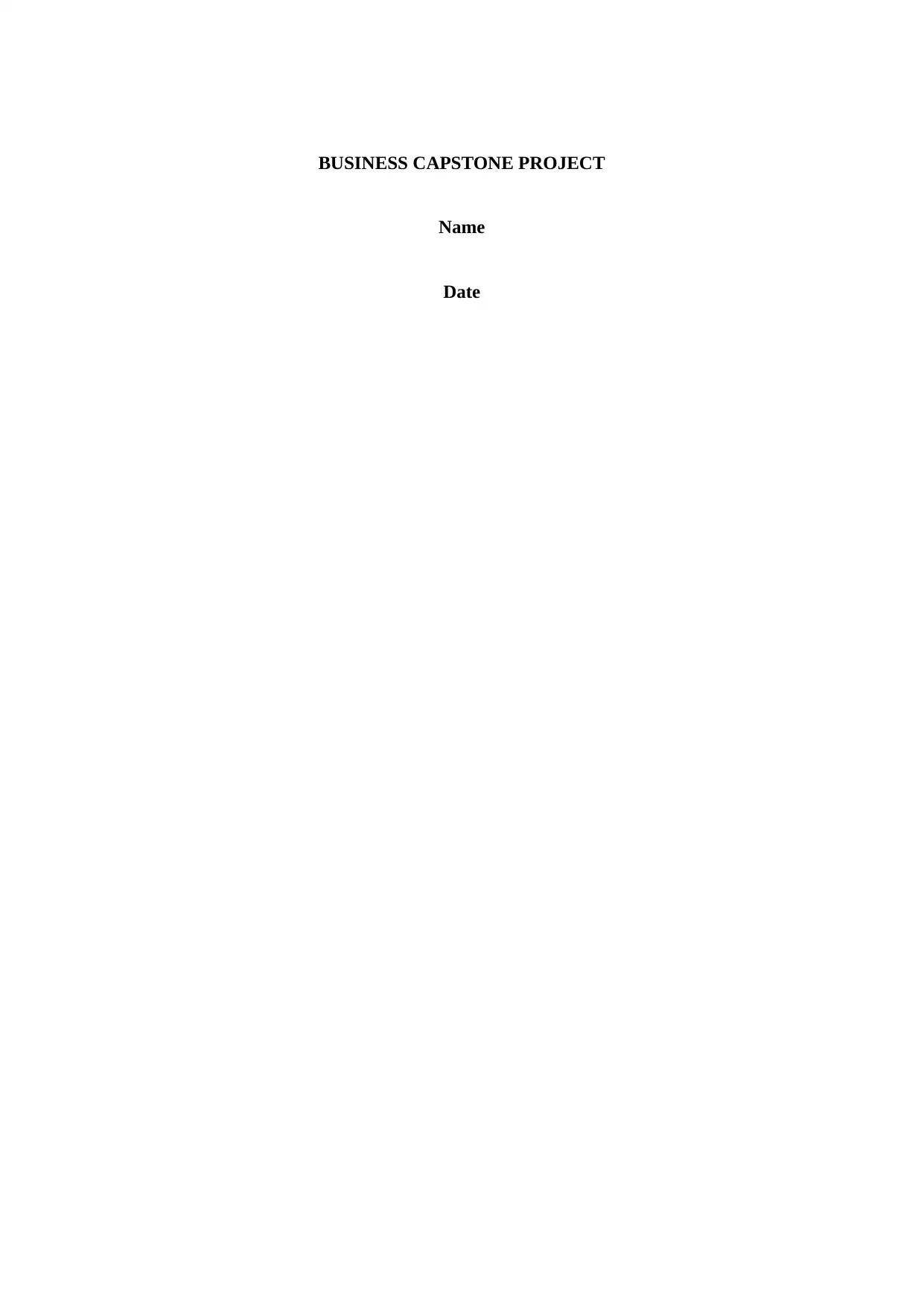
BUSINESS CAPSTONE PROJECT
Name
Date
Name
Date
Paraphrase This Document
Need a fresh take? Get an instant paraphrase of this document with our AI Paraphraser
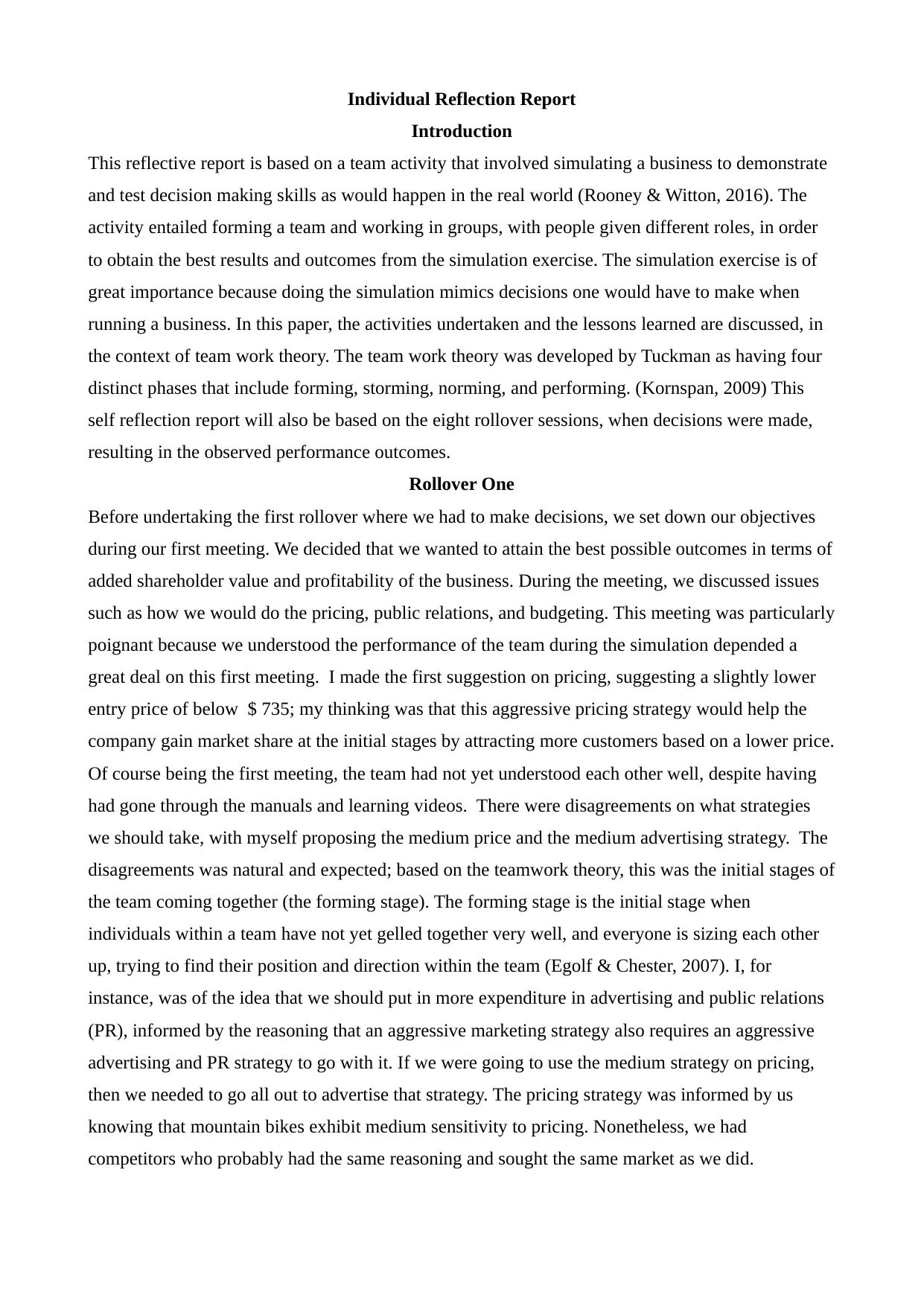
Individual Reflection Report
Introduction
This reflective report is based on a team activity that involved simulating a business to demonstrate
and test decision making skills as would happen in the real world (Rooney & Witton, 2016). The
activity entailed forming a team and working in groups, with people given different roles, in order
to obtain the best results and outcomes from the simulation exercise. The simulation exercise is of
great importance because doing the simulation mimics decisions one would have to make when
running a business. In this paper, the activities undertaken and the lessons learned are discussed, in
the context of team work theory. The team work theory was developed by Tuckman as having four
distinct phases that include forming, storming, norming, and performing. (Kornspan, 2009) This
self reflection report will also be based on the eight rollover sessions, when decisions were made,
resulting in the observed performance outcomes.
Rollover One
Before undertaking the first rollover where we had to make decisions, we set down our objectives
during our first meeting. We decided that we wanted to attain the best possible outcomes in terms of
added shareholder value and profitability of the business. During the meeting, we discussed issues
such as how we would do the pricing, public relations, and budgeting. This meeting was particularly
poignant because we understood the performance of the team during the simulation depended a
great deal on this first meeting. I made the first suggestion on pricing, suggesting a slightly lower
entry price of below $ 735; my thinking was that this aggressive pricing strategy would help the
company gain market share at the initial stages by attracting more customers based on a lower price.
Of course being the first meeting, the team had not yet understood each other well, despite having
had gone through the manuals and learning videos. There were disagreements on what strategies
we should take, with myself proposing the medium price and the medium advertising strategy. The
disagreements was natural and expected; based on the teamwork theory, this was the initial stages of
the team coming together (the forming stage). The forming stage is the initial stage when
individuals within a team have not yet gelled together very well, and everyone is sizing each other
up, trying to find their position and direction within the team (Egolf & Chester, 2007). I, for
instance, was of the idea that we should put in more expenditure in advertising and public relations
(PR), informed by the reasoning that an aggressive marketing strategy also requires an aggressive
advertising and PR strategy to go with it. If we were going to use the medium strategy on pricing,
then we needed to go all out to advertise that strategy. The pricing strategy was informed by us
knowing that mountain bikes exhibit medium sensitivity to pricing. Nonetheless, we had
competitors who probably had the same reasoning and sought the same market as we did.
Introduction
This reflective report is based on a team activity that involved simulating a business to demonstrate
and test decision making skills as would happen in the real world (Rooney & Witton, 2016). The
activity entailed forming a team and working in groups, with people given different roles, in order
to obtain the best results and outcomes from the simulation exercise. The simulation exercise is of
great importance because doing the simulation mimics decisions one would have to make when
running a business. In this paper, the activities undertaken and the lessons learned are discussed, in
the context of team work theory. The team work theory was developed by Tuckman as having four
distinct phases that include forming, storming, norming, and performing. (Kornspan, 2009) This
self reflection report will also be based on the eight rollover sessions, when decisions were made,
resulting in the observed performance outcomes.
Rollover One
Before undertaking the first rollover where we had to make decisions, we set down our objectives
during our first meeting. We decided that we wanted to attain the best possible outcomes in terms of
added shareholder value and profitability of the business. During the meeting, we discussed issues
such as how we would do the pricing, public relations, and budgeting. This meeting was particularly
poignant because we understood the performance of the team during the simulation depended a
great deal on this first meeting. I made the first suggestion on pricing, suggesting a slightly lower
entry price of below $ 735; my thinking was that this aggressive pricing strategy would help the
company gain market share at the initial stages by attracting more customers based on a lower price.
Of course being the first meeting, the team had not yet understood each other well, despite having
had gone through the manuals and learning videos. There were disagreements on what strategies
we should take, with myself proposing the medium price and the medium advertising strategy. The
disagreements was natural and expected; based on the teamwork theory, this was the initial stages of
the team coming together (the forming stage). The forming stage is the initial stage when
individuals within a team have not yet gelled together very well, and everyone is sizing each other
up, trying to find their position and direction within the team (Egolf & Chester, 2007). I, for
instance, was of the idea that we should put in more expenditure in advertising and public relations
(PR), informed by the reasoning that an aggressive marketing strategy also requires an aggressive
advertising and PR strategy to go with it. If we were going to use the medium strategy on pricing,
then we needed to go all out to advertise that strategy. The pricing strategy was informed by us
knowing that mountain bikes exhibit medium sensitivity to pricing. Nonetheless, we had
competitors who probably had the same reasoning and sought the same market as we did.
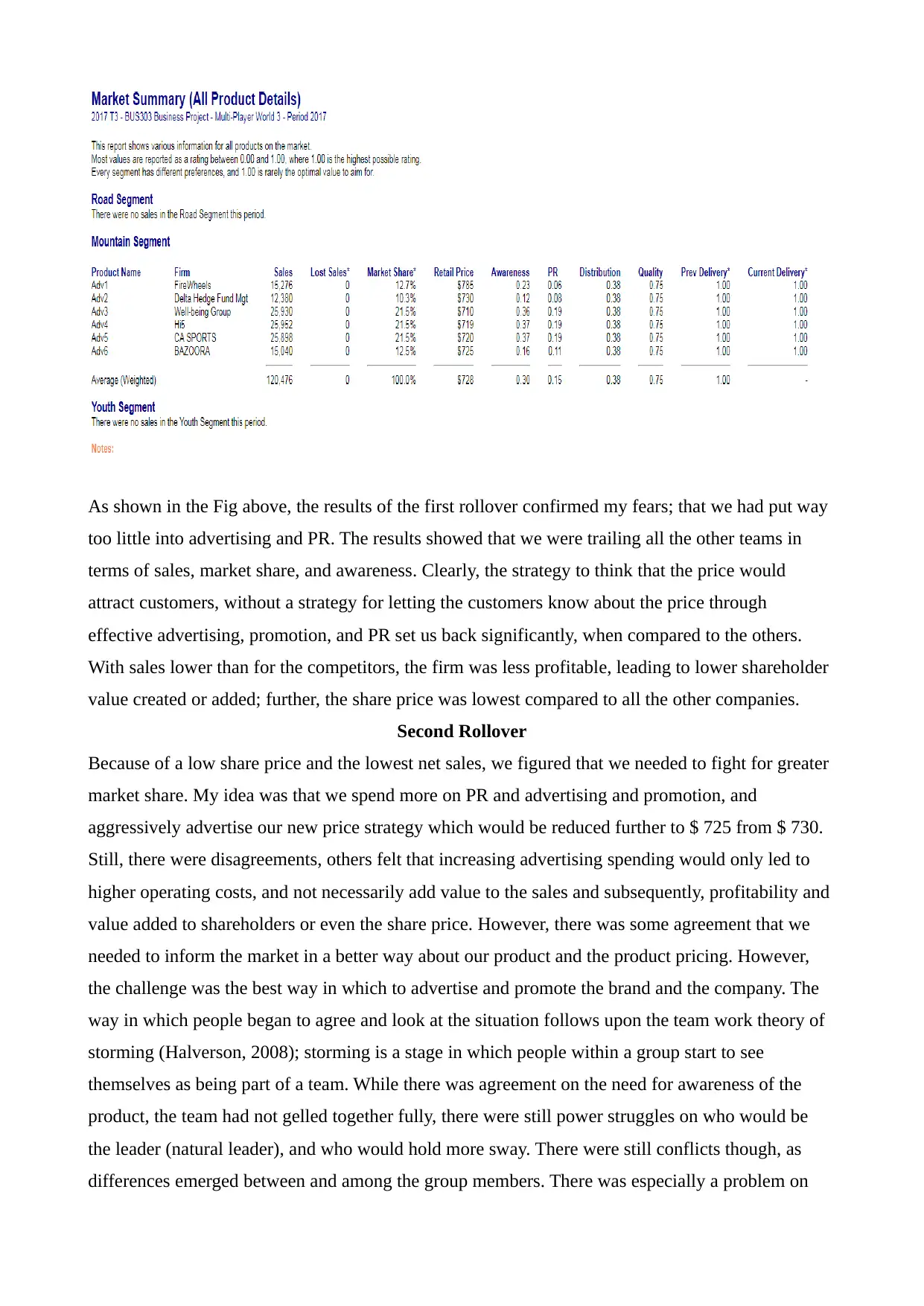
As shown in the Fig above, the results of the first rollover confirmed my fears; that we had put way
too little into advertising and PR. The results showed that we were trailing all the other teams in
terms of sales, market share, and awareness. Clearly, the strategy to think that the price would
attract customers, without a strategy for letting the customers know about the price through
effective advertising, promotion, and PR set us back significantly, when compared to the others.
With sales lower than for the competitors, the firm was less profitable, leading to lower shareholder
value created or added; further, the share price was lowest compared to all the other companies.
Second Rollover
Because of a low share price and the lowest net sales, we figured that we needed to fight for greater
market share. My idea was that we spend more on PR and advertising and promotion, and
aggressively advertise our new price strategy which would be reduced further to $ 725 from $ 730.
Still, there were disagreements, others felt that increasing advertising spending would only led to
higher operating costs, and not necessarily add value to the sales and subsequently, profitability and
value added to shareholders or even the share price. However, there was some agreement that we
needed to inform the market in a better way about our product and the product pricing. However,
the challenge was the best way in which to advertise and promote the brand and the company. The
way in which people began to agree and look at the situation follows upon the team work theory of
storming (Halverson, 2008); storming is a stage in which people within a group start to see
themselves as being part of a team. While there was agreement on the need for awareness of the
product, the team had not gelled together fully, there were still power struggles on who would be
the leader (natural leader), and who would hold more sway. There were still conflicts though, as
differences emerged between and among the group members. There was especially a problem on
too little into advertising and PR. The results showed that we were trailing all the other teams in
terms of sales, market share, and awareness. Clearly, the strategy to think that the price would
attract customers, without a strategy for letting the customers know about the price through
effective advertising, promotion, and PR set us back significantly, when compared to the others.
With sales lower than for the competitors, the firm was less profitable, leading to lower shareholder
value created or added; further, the share price was lowest compared to all the other companies.
Second Rollover
Because of a low share price and the lowest net sales, we figured that we needed to fight for greater
market share. My idea was that we spend more on PR and advertising and promotion, and
aggressively advertise our new price strategy which would be reduced further to $ 725 from $ 730.
Still, there were disagreements, others felt that increasing advertising spending would only led to
higher operating costs, and not necessarily add value to the sales and subsequently, profitability and
value added to shareholders or even the share price. However, there was some agreement that we
needed to inform the market in a better way about our product and the product pricing. However,
the challenge was the best way in which to advertise and promote the brand and the company. The
way in which people began to agree and look at the situation follows upon the team work theory of
storming (Halverson, 2008); storming is a stage in which people within a group start to see
themselves as being part of a team. While there was agreement on the need for awareness of the
product, the team had not gelled together fully, there were still power struggles on who would be
the leader (natural leader), and who would hold more sway. There were still conflicts though, as
differences emerged between and among the group members. There was especially a problem on
⊘ This is a preview!⊘
Do you want full access?
Subscribe today to unlock all pages.

Trusted by 1+ million students worldwide
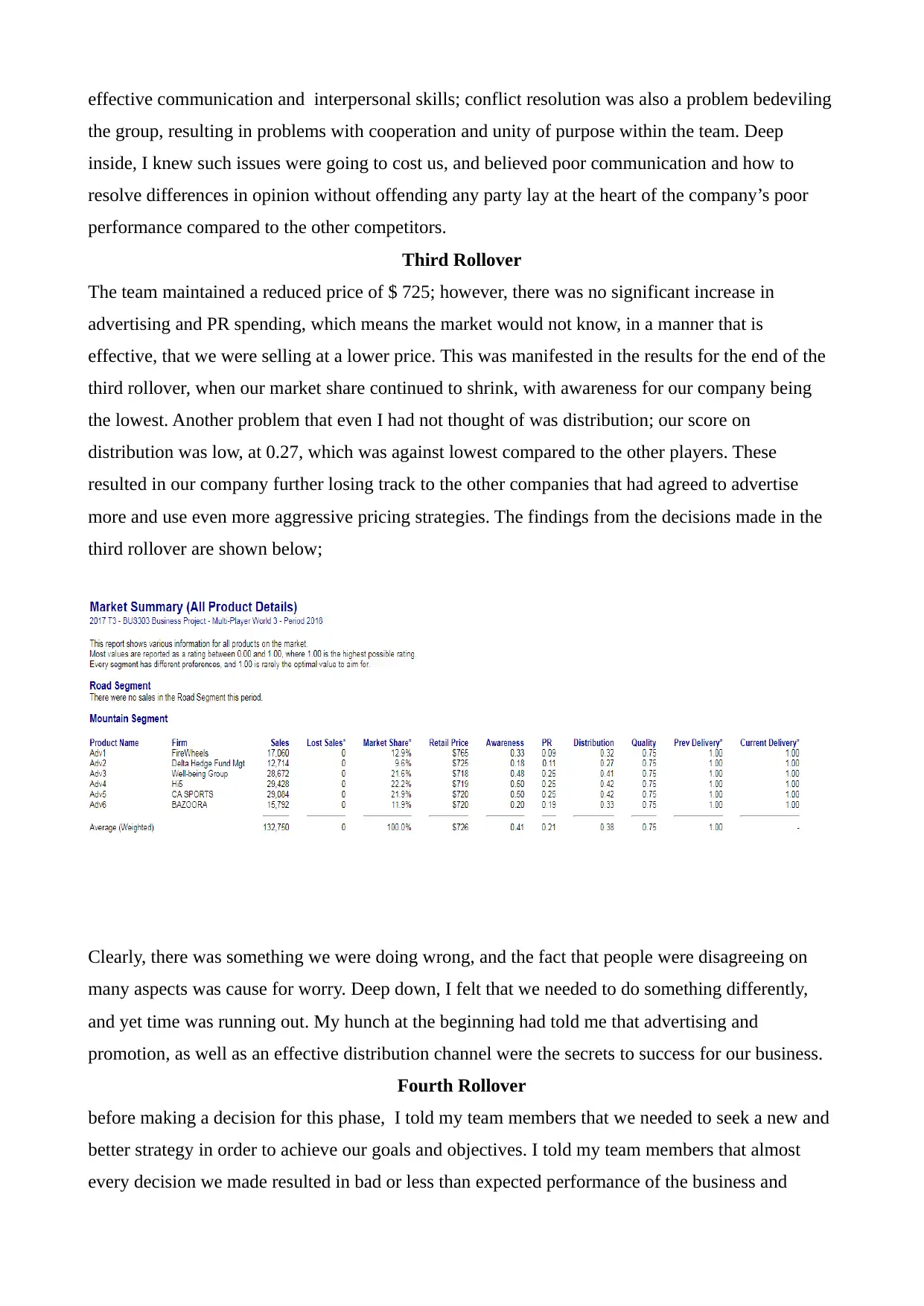
effective communication and interpersonal skills; conflict resolution was also a problem bedeviling
the group, resulting in problems with cooperation and unity of purpose within the team. Deep
inside, I knew such issues were going to cost us, and believed poor communication and how to
resolve differences in opinion without offending any party lay at the heart of the company’s poor
performance compared to the other competitors.
Third Rollover
The team maintained a reduced price of $ 725; however, there was no significant increase in
advertising and PR spending, which means the market would not know, in a manner that is
effective, that we were selling at a lower price. This was manifested in the results for the end of the
third rollover, when our market share continued to shrink, with awareness for our company being
the lowest. Another problem that even I had not thought of was distribution; our score on
distribution was low, at 0.27, which was against lowest compared to the other players. These
resulted in our company further losing track to the other companies that had agreed to advertise
more and use even more aggressive pricing strategies. The findings from the decisions made in the
third rollover are shown below;
Clearly, there was something we were doing wrong, and the fact that people were disagreeing on
many aspects was cause for worry. Deep down, I felt that we needed to do something differently,
and yet time was running out. My hunch at the beginning had told me that advertising and
promotion, as well as an effective distribution channel were the secrets to success for our business.
Fourth Rollover
before making a decision for this phase, I told my team members that we needed to seek a new and
better strategy in order to achieve our goals and objectives. I told my team members that almost
every decision we made resulted in bad or less than expected performance of the business and
the group, resulting in problems with cooperation and unity of purpose within the team. Deep
inside, I knew such issues were going to cost us, and believed poor communication and how to
resolve differences in opinion without offending any party lay at the heart of the company’s poor
performance compared to the other competitors.
Third Rollover
The team maintained a reduced price of $ 725; however, there was no significant increase in
advertising and PR spending, which means the market would not know, in a manner that is
effective, that we were selling at a lower price. This was manifested in the results for the end of the
third rollover, when our market share continued to shrink, with awareness for our company being
the lowest. Another problem that even I had not thought of was distribution; our score on
distribution was low, at 0.27, which was against lowest compared to the other players. These
resulted in our company further losing track to the other companies that had agreed to advertise
more and use even more aggressive pricing strategies. The findings from the decisions made in the
third rollover are shown below;
Clearly, there was something we were doing wrong, and the fact that people were disagreeing on
many aspects was cause for worry. Deep down, I felt that we needed to do something differently,
and yet time was running out. My hunch at the beginning had told me that advertising and
promotion, as well as an effective distribution channel were the secrets to success for our business.
Fourth Rollover
before making a decision for this phase, I told my team members that we needed to seek a new and
better strategy in order to achieve our goals and objectives. I told my team members that almost
every decision we made resulted in bad or less than expected performance of the business and
Paraphrase This Document
Need a fresh take? Get an instant paraphrase of this document with our AI Paraphraser
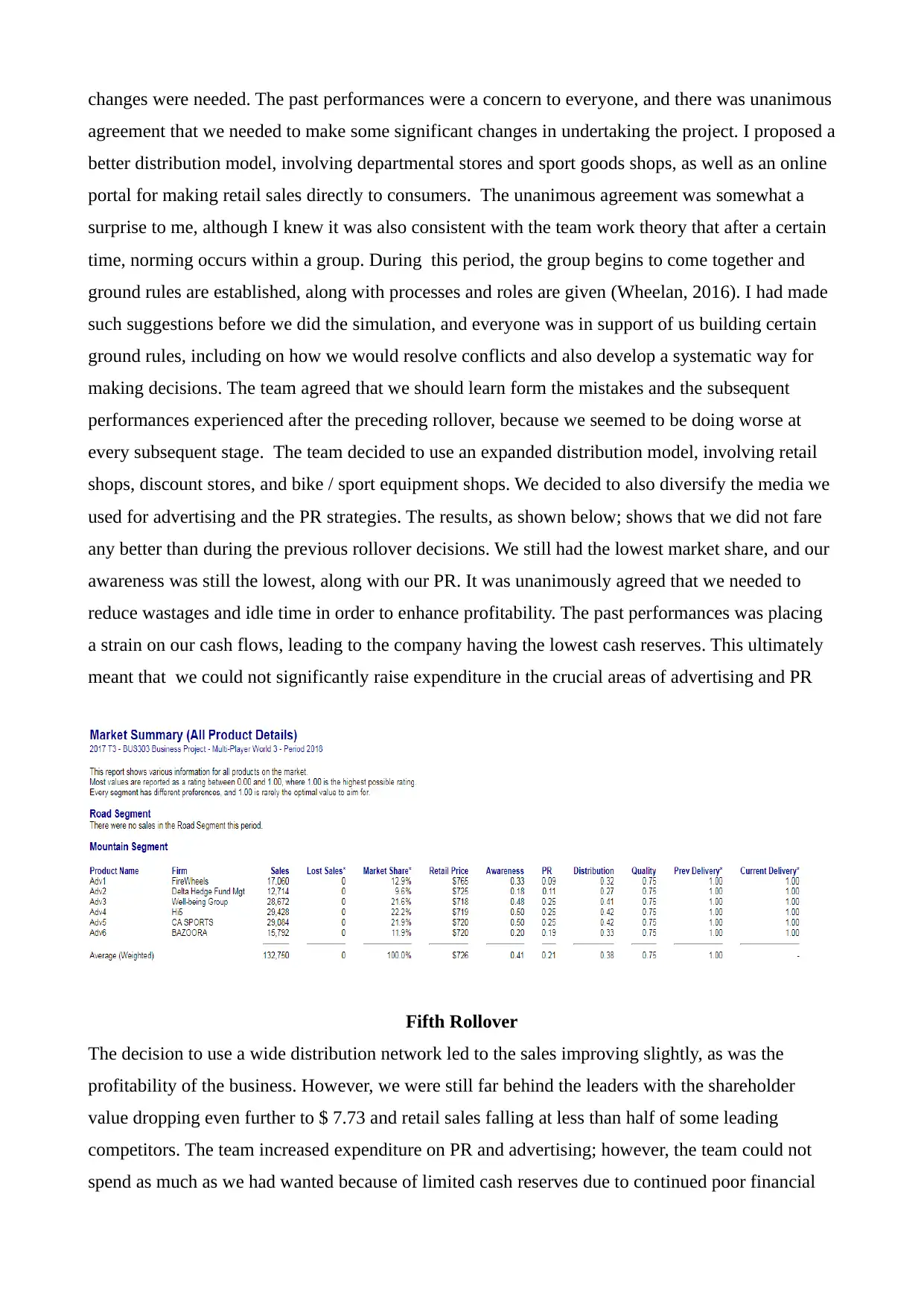
changes were needed. The past performances were a concern to everyone, and there was unanimous
agreement that we needed to make some significant changes in undertaking the project. I proposed a
better distribution model, involving departmental stores and sport goods shops, as well as an online
portal for making retail sales directly to consumers. The unanimous agreement was somewhat a
surprise to me, although I knew it was also consistent with the team work theory that after a certain
time, norming occurs within a group. During this period, the group begins to come together and
ground rules are established, along with processes and roles are given (Wheelan, 2016). I had made
such suggestions before we did the simulation, and everyone was in support of us building certain
ground rules, including on how we would resolve conflicts and also develop a systematic way for
making decisions. The team agreed that we should learn form the mistakes and the subsequent
performances experienced after the preceding rollover, because we seemed to be doing worse at
every subsequent stage. The team decided to use an expanded distribution model, involving retail
shops, discount stores, and bike / sport equipment shops. We decided to also diversify the media we
used for advertising and the PR strategies. The results, as shown below; shows that we did not fare
any better than during the previous rollover decisions. We still had the lowest market share, and our
awareness was still the lowest, along with our PR. It was unanimously agreed that we needed to
reduce wastages and idle time in order to enhance profitability. The past performances was placing
a strain on our cash flows, leading to the company having the lowest cash reserves. This ultimately
meant that we could not significantly raise expenditure in the crucial areas of advertising and PR
Fifth Rollover
The decision to use a wide distribution network led to the sales improving slightly, as was the
profitability of the business. However, we were still far behind the leaders with the shareholder
value dropping even further to $ 7.73 and retail sales falling at less than half of some leading
competitors. The team increased expenditure on PR and advertising; however, the team could not
spend as much as we had wanted because of limited cash reserves due to continued poor financial
agreement that we needed to make some significant changes in undertaking the project. I proposed a
better distribution model, involving departmental stores and sport goods shops, as well as an online
portal for making retail sales directly to consumers. The unanimous agreement was somewhat a
surprise to me, although I knew it was also consistent with the team work theory that after a certain
time, norming occurs within a group. During this period, the group begins to come together and
ground rules are established, along with processes and roles are given (Wheelan, 2016). I had made
such suggestions before we did the simulation, and everyone was in support of us building certain
ground rules, including on how we would resolve conflicts and also develop a systematic way for
making decisions. The team agreed that we should learn form the mistakes and the subsequent
performances experienced after the preceding rollover, because we seemed to be doing worse at
every subsequent stage. The team decided to use an expanded distribution model, involving retail
shops, discount stores, and bike / sport equipment shops. We decided to also diversify the media we
used for advertising and the PR strategies. The results, as shown below; shows that we did not fare
any better than during the previous rollover decisions. We still had the lowest market share, and our
awareness was still the lowest, along with our PR. It was unanimously agreed that we needed to
reduce wastages and idle time in order to enhance profitability. The past performances was placing
a strain on our cash flows, leading to the company having the lowest cash reserves. This ultimately
meant that we could not significantly raise expenditure in the crucial areas of advertising and PR
Fifth Rollover
The decision to use a wide distribution network led to the sales improving slightly, as was the
profitability of the business. However, we were still far behind the leaders with the shareholder
value dropping even further to $ 7.73 and retail sales falling at less than half of some leading
competitors. The team increased expenditure on PR and advertising; however, the team could not
spend as much as we had wanted because of limited cash reserves due to continued poor financial
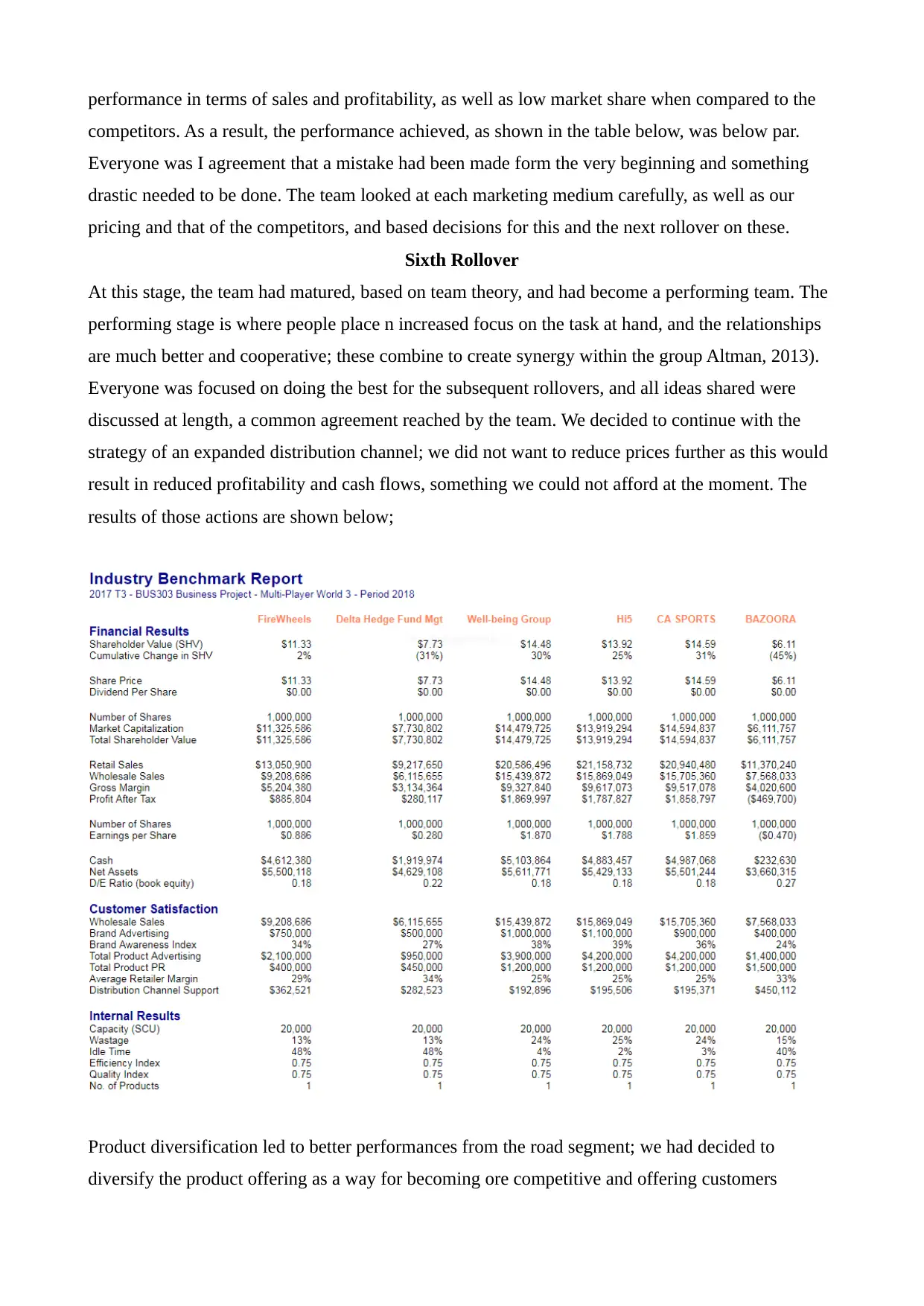
performance in terms of sales and profitability, as well as low market share when compared to the
competitors. As a result, the performance achieved, as shown in the table below, was below par.
Everyone was I agreement that a mistake had been made form the very beginning and something
drastic needed to be done. The team looked at each marketing medium carefully, as well as our
pricing and that of the competitors, and based decisions for this and the next rollover on these.
Sixth Rollover
At this stage, the team had matured, based on team theory, and had become a performing team. The
performing stage is where people place n increased focus on the task at hand, and the relationships
are much better and cooperative; these combine to create synergy within the group Altman, 2013).
Everyone was focused on doing the best for the subsequent rollovers, and all ideas shared were
discussed at length, a common agreement reached by the team. We decided to continue with the
strategy of an expanded distribution channel; we did not want to reduce prices further as this would
result in reduced profitability and cash flows, something we could not afford at the moment. The
results of those actions are shown below;
Product diversification led to better performances from the road segment; we had decided to
diversify the product offering as a way for becoming ore competitive and offering customers
competitors. As a result, the performance achieved, as shown in the table below, was below par.
Everyone was I agreement that a mistake had been made form the very beginning and something
drastic needed to be done. The team looked at each marketing medium carefully, as well as our
pricing and that of the competitors, and based decisions for this and the next rollover on these.
Sixth Rollover
At this stage, the team had matured, based on team theory, and had become a performing team. The
performing stage is where people place n increased focus on the task at hand, and the relationships
are much better and cooperative; these combine to create synergy within the group Altman, 2013).
Everyone was focused on doing the best for the subsequent rollovers, and all ideas shared were
discussed at length, a common agreement reached by the team. We decided to continue with the
strategy of an expanded distribution channel; we did not want to reduce prices further as this would
result in reduced profitability and cash flows, something we could not afford at the moment. The
results of those actions are shown below;
Product diversification led to better performances from the road segment; we had decided to
diversify the product offering as a way for becoming ore competitive and offering customers
⊘ This is a preview!⊘
Do you want full access?
Subscribe today to unlock all pages.

Trusted by 1+ million students worldwide
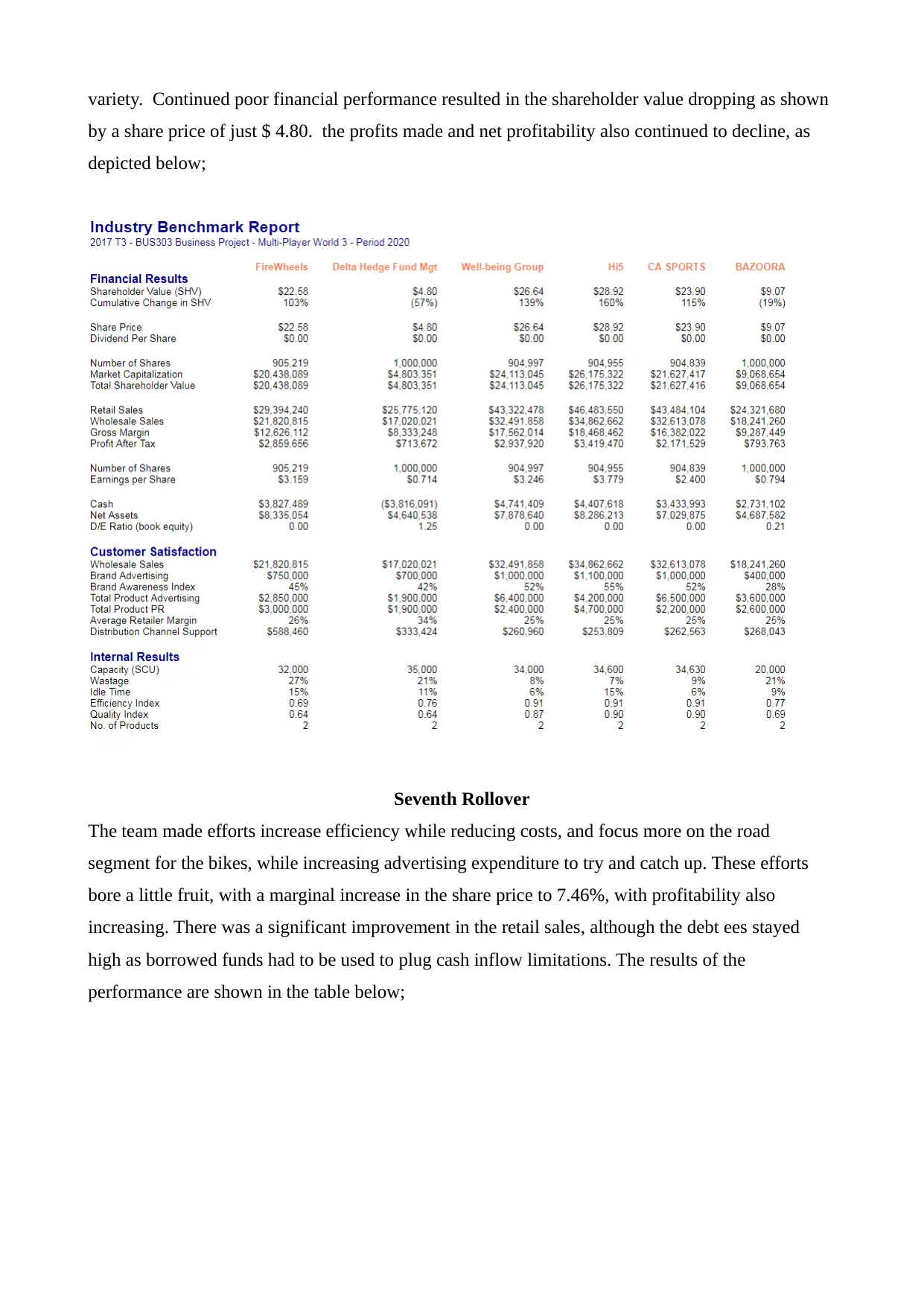
variety. Continued poor financial performance resulted in the shareholder value dropping as shown
by a share price of just $ 4.80. the profits made and net profitability also continued to decline, as
depicted below;
Seventh Rollover
The team made efforts increase efficiency while reducing costs, and focus more on the road
segment for the bikes, while increasing advertising expenditure to try and catch up. These efforts
bore a little fruit, with a marginal increase in the share price to 7.46%, with profitability also
increasing. There was a significant improvement in the retail sales, although the debt ees stayed
high as borrowed funds had to be used to plug cash inflow limitations. The results of the
performance are shown in the table below;
by a share price of just $ 4.80. the profits made and net profitability also continued to decline, as
depicted below;
Seventh Rollover
The team made efforts increase efficiency while reducing costs, and focus more on the road
segment for the bikes, while increasing advertising expenditure to try and catch up. These efforts
bore a little fruit, with a marginal increase in the share price to 7.46%, with profitability also
increasing. There was a significant improvement in the retail sales, although the debt ees stayed
high as borrowed funds had to be used to plug cash inflow limitations. The results of the
performance are shown in the table below;
Paraphrase This Document
Need a fresh take? Get an instant paraphrase of this document with our AI Paraphraser
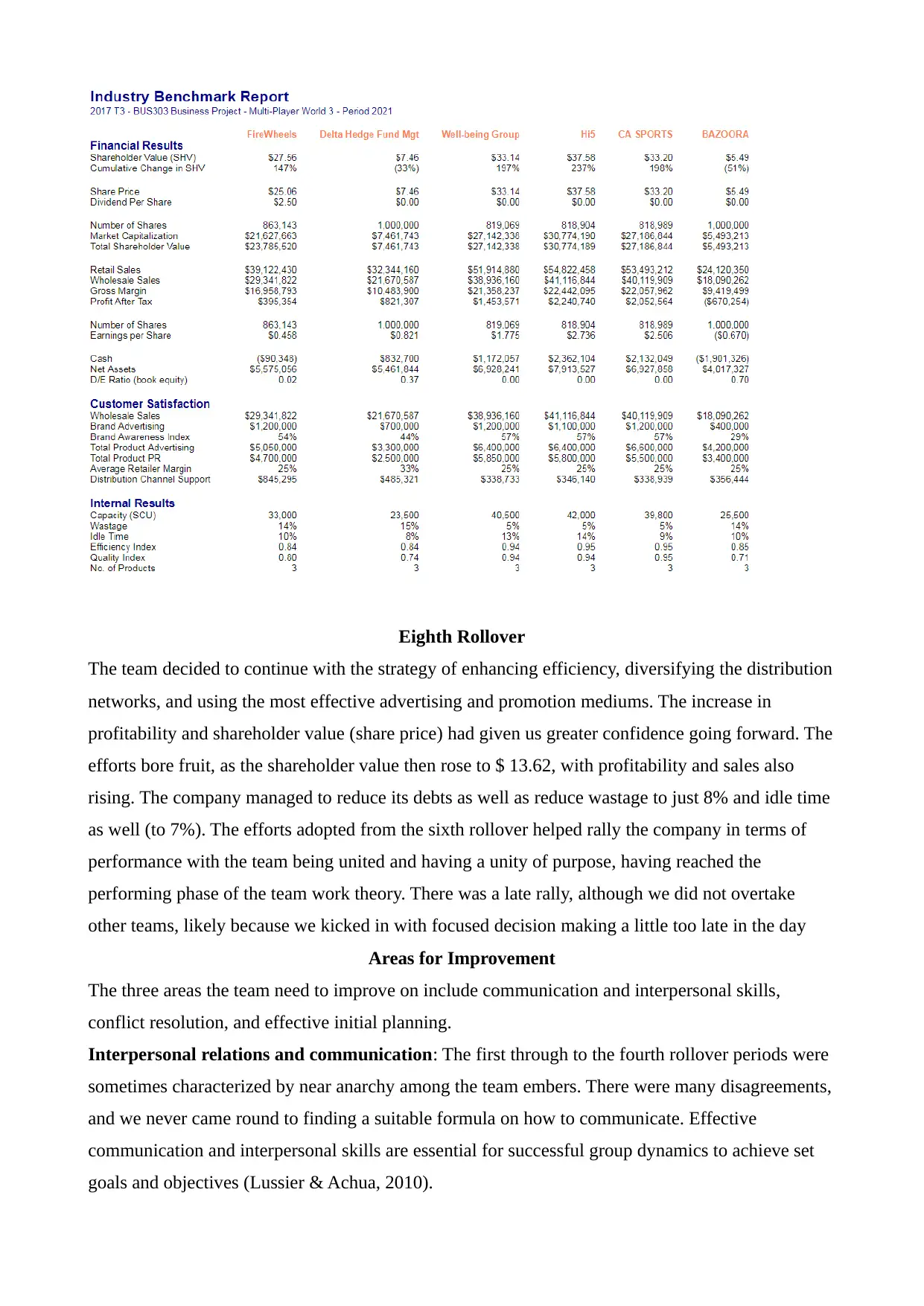
Eighth Rollover
The team decided to continue with the strategy of enhancing efficiency, diversifying the distribution
networks, and using the most effective advertising and promotion mediums. The increase in
profitability and shareholder value (share price) had given us greater confidence going forward. The
efforts bore fruit, as the shareholder value then rose to $ 13.62, with profitability and sales also
rising. The company managed to reduce its debts as well as reduce wastage to just 8% and idle time
as well (to 7%). The efforts adopted from the sixth rollover helped rally the company in terms of
performance with the team being united and having a unity of purpose, having reached the
performing phase of the team work theory. There was a late rally, although we did not overtake
other teams, likely because we kicked in with focused decision making a little too late in the day
Areas for Improvement
The three areas the team need to improve on include communication and interpersonal skills,
conflict resolution, and effective initial planning.
Interpersonal relations and communication: The first through to the fourth rollover periods were
sometimes characterized by near anarchy among the team embers. There were many disagreements,
and we never came round to finding a suitable formula on how to communicate. Effective
communication and interpersonal skills are essential for successful group dynamics to achieve set
goals and objectives (Lussier & Achua, 2010).
The team decided to continue with the strategy of enhancing efficiency, diversifying the distribution
networks, and using the most effective advertising and promotion mediums. The increase in
profitability and shareholder value (share price) had given us greater confidence going forward. The
efforts bore fruit, as the shareholder value then rose to $ 13.62, with profitability and sales also
rising. The company managed to reduce its debts as well as reduce wastage to just 8% and idle time
as well (to 7%). The efforts adopted from the sixth rollover helped rally the company in terms of
performance with the team being united and having a unity of purpose, having reached the
performing phase of the team work theory. There was a late rally, although we did not overtake
other teams, likely because we kicked in with focused decision making a little too late in the day
Areas for Improvement
The three areas the team need to improve on include communication and interpersonal skills,
conflict resolution, and effective initial planning.
Interpersonal relations and communication: The first through to the fourth rollover periods were
sometimes characterized by near anarchy among the team embers. There were many disagreements,
and we never came round to finding a suitable formula on how to communicate. Effective
communication and interpersonal skills are essential for successful group dynamics to achieve set
goals and objectives (Lussier & Achua, 2010).
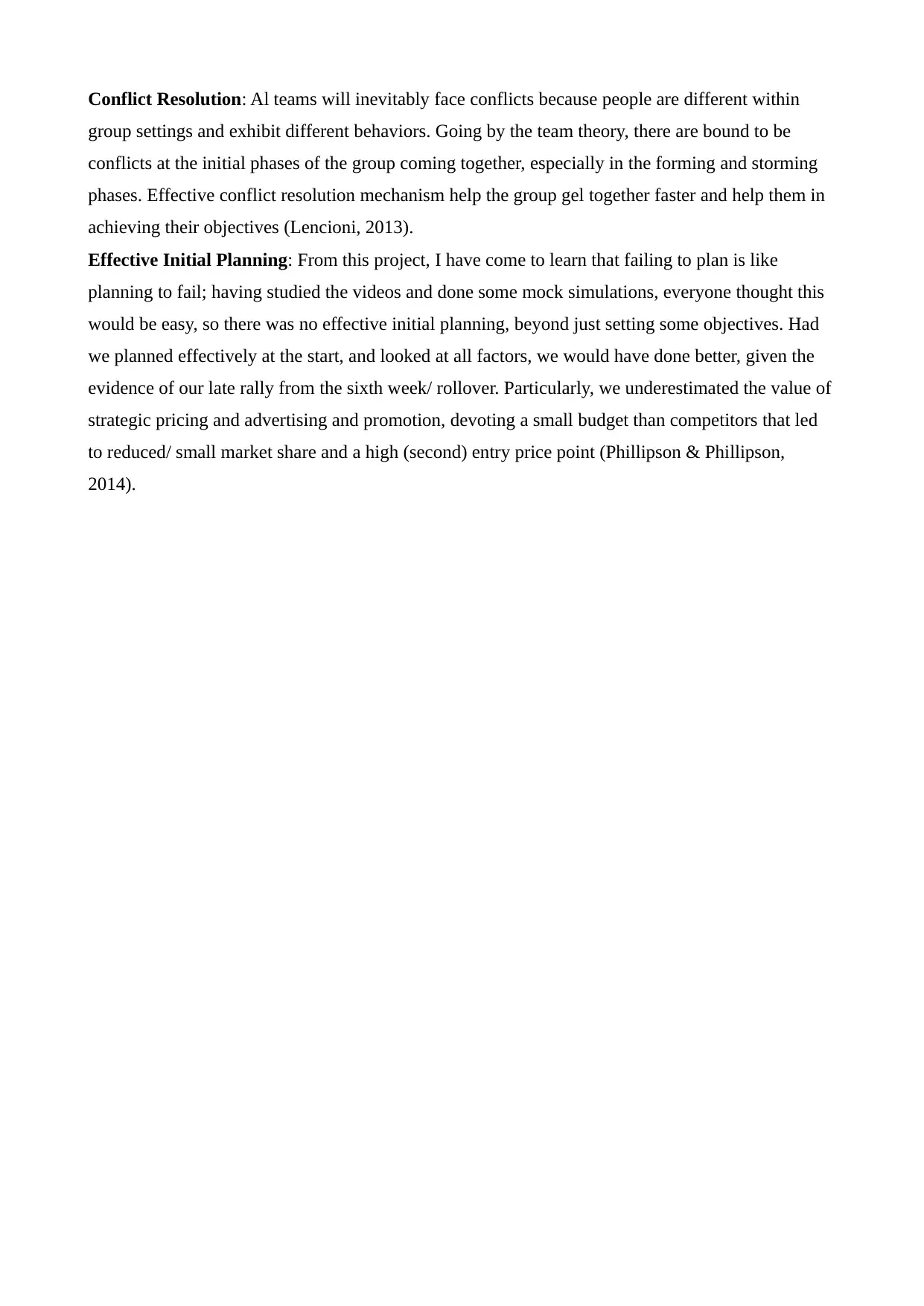
Conflict Resolution: Al teams will inevitably face conflicts because people are different within
group settings and exhibit different behaviors. Going by the team theory, there are bound to be
conflicts at the initial phases of the group coming together, especially in the forming and storming
phases. Effective conflict resolution mechanism help the group gel together faster and help them in
achieving their objectives (Lencioni, 2013).
Effective Initial Planning: From this project, I have come to learn that failing to plan is like
planning to fail; having studied the videos and done some mock simulations, everyone thought this
would be easy, so there was no effective initial planning, beyond just setting some objectives. Had
we planned effectively at the start, and looked at all factors, we would have done better, given the
evidence of our late rally from the sixth week/ rollover. Particularly, we underestimated the value of
strategic pricing and advertising and promotion, devoting a small budget than competitors that led
to reduced/ small market share and a high (second) entry price point (Phillipson & Phillipson,
2014).
group settings and exhibit different behaviors. Going by the team theory, there are bound to be
conflicts at the initial phases of the group coming together, especially in the forming and storming
phases. Effective conflict resolution mechanism help the group gel together faster and help them in
achieving their objectives (Lencioni, 2013).
Effective Initial Planning: From this project, I have come to learn that failing to plan is like
planning to fail; having studied the videos and done some mock simulations, everyone thought this
would be easy, so there was no effective initial planning, beyond just setting some objectives. Had
we planned effectively at the start, and looked at all factors, we would have done better, given the
evidence of our late rally from the sixth week/ rollover. Particularly, we underestimated the value of
strategic pricing and advertising and promotion, devoting a small budget than competitors that led
to reduced/ small market share and a high (second) entry price point (Phillipson & Phillipson,
2014).
⊘ This is a preview!⊘
Do you want full access?
Subscribe today to unlock all pages.

Trusted by 1+ million students worldwide
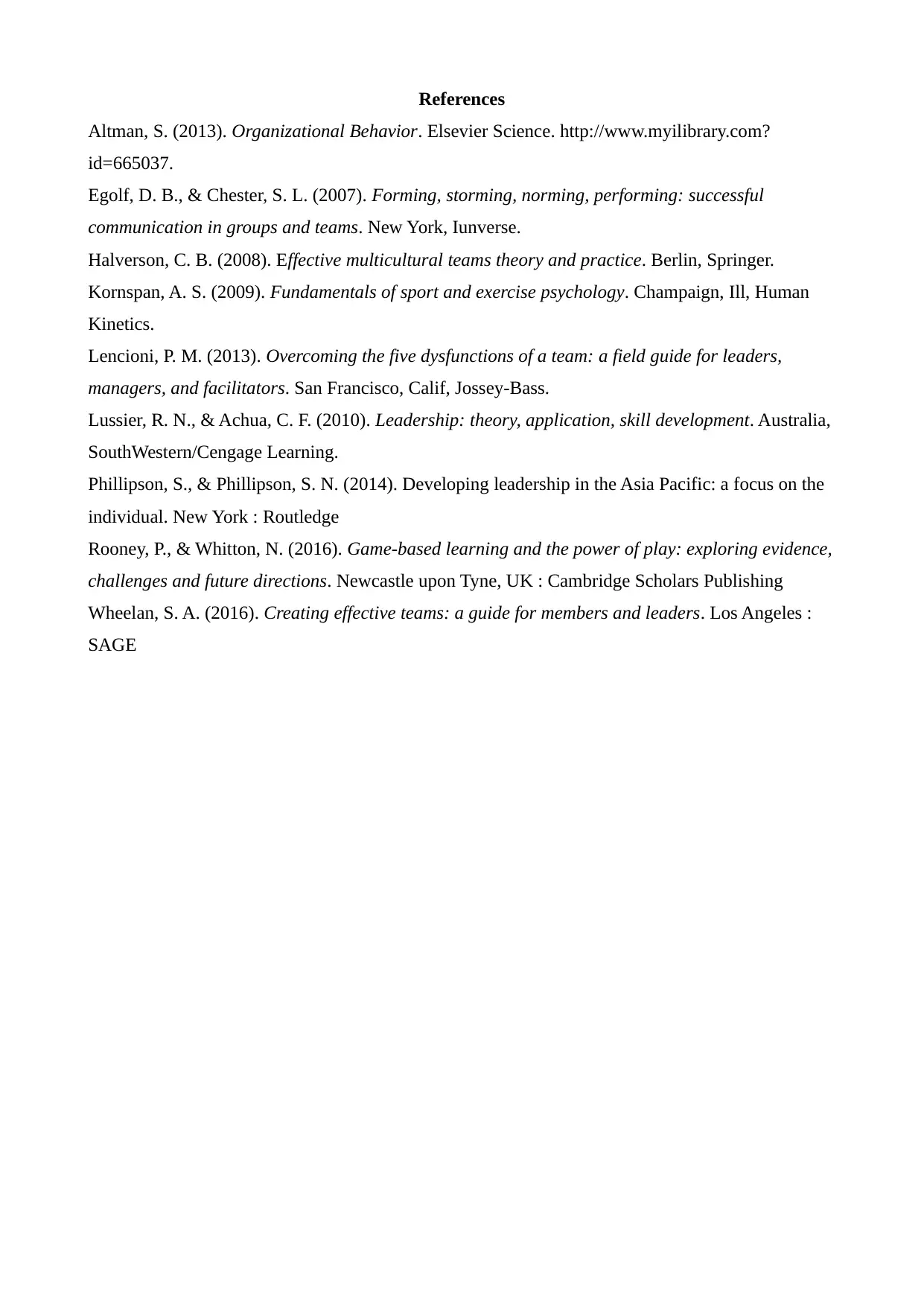
References
Altman, S. (2013). Organizational Behavior. Elsevier Science. http://www.myilibrary.com?
id=665037.
Egolf, D. B., & Chester, S. L. (2007). Forming, storming, norming, performing: successful
communication in groups and teams. New York, Iunverse.
Halverson, C. B. (2008). Effective multicultural teams theory and practice. Berlin, Springer.
Kornspan, A. S. (2009). Fundamentals of sport and exercise psychology. Champaign, Ill, Human
Kinetics.
Lencioni, P. M. (2013). Overcoming the five dysfunctions of a team: a field guide for leaders,
managers, and facilitators. San Francisco, Calif, Jossey-Bass.
Lussier, R. N., & Achua, C. F. (2010). Leadership: theory, application, skill development. Australia,
SouthWestern/Cengage Learning.
Phillipson, S., & Phillipson, S. N. (2014). Developing leadership in the Asia Pacific: a focus on the
individual. New York : Routledge
Rooney, P., & Whitton, N. (2016). Game-based learning and the power of play: exploring evidence,
challenges and future directions. Newcastle upon Tyne, UK : Cambridge Scholars Publishing
Wheelan, S. A. (2016). Creating effective teams: a guide for members and leaders. Los Angeles :
SAGE
Altman, S. (2013). Organizational Behavior. Elsevier Science. http://www.myilibrary.com?
id=665037.
Egolf, D. B., & Chester, S. L. (2007). Forming, storming, norming, performing: successful
communication in groups and teams. New York, Iunverse.
Halverson, C. B. (2008). Effective multicultural teams theory and practice. Berlin, Springer.
Kornspan, A. S. (2009). Fundamentals of sport and exercise psychology. Champaign, Ill, Human
Kinetics.
Lencioni, P. M. (2013). Overcoming the five dysfunctions of a team: a field guide for leaders,
managers, and facilitators. San Francisco, Calif, Jossey-Bass.
Lussier, R. N., & Achua, C. F. (2010). Leadership: theory, application, skill development. Australia,
SouthWestern/Cengage Learning.
Phillipson, S., & Phillipson, S. N. (2014). Developing leadership in the Asia Pacific: a focus on the
individual. New York : Routledge
Rooney, P., & Whitton, N. (2016). Game-based learning and the power of play: exploring evidence,
challenges and future directions. Newcastle upon Tyne, UK : Cambridge Scholars Publishing
Wheelan, S. A. (2016). Creating effective teams: a guide for members and leaders. Los Angeles :
SAGE
1 out of 10
Related Documents
Your All-in-One AI-Powered Toolkit for Academic Success.
+13062052269
info@desklib.com
Available 24*7 on WhatsApp / Email
![[object Object]](/_next/static/media/star-bottom.7253800d.svg)
Unlock your academic potential
Copyright © 2020–2025 A2Z Services. All Rights Reserved. Developed and managed by ZUCOL.





